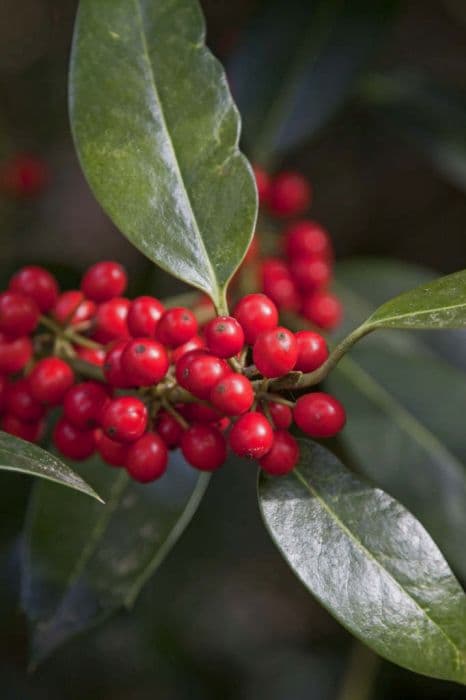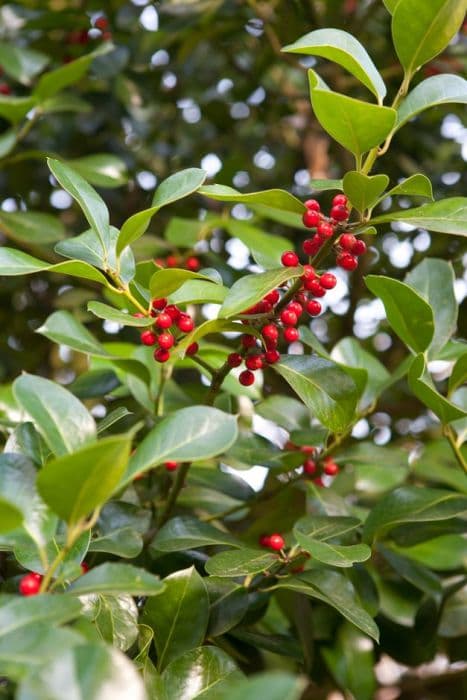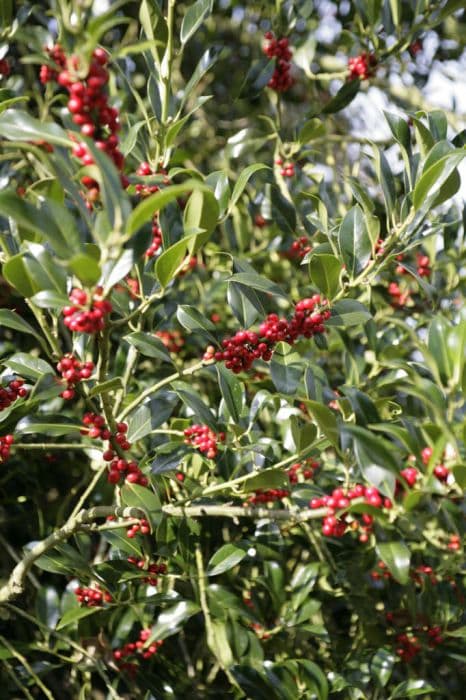Yellow-berried Holly Ilex aquifolium 'Bacciflava' (f)

ABOUT
The plant commonly known as the 'Bacciflava' Holly is recognizable by its distinctive leaves and berries. The leaves are glossy with a rich, dark green color that creates a striking backdrop for the berries and other features of the plant. Each leaf is notably edged with spiky teeth, which are a characteristic feature of hollies. The shape of the leaves is typically oval, coming to a point at the end, and they have a leathery texture that adds to the plant's robust appearance. In contrast to the dark foliage, 'Bacciflava' Holly produces bright yellow berries that add a vibrant pop of color and are a main highlight of this plant. These berries traditionally stand out against the dark leaves, providing a showy display that can catch the eye from a distance. The contrast of the berries against the leaves makes this particular variety of holly quite a striking specimen in any garden setting. The overall form of 'Bacciflava' Holly is dense and bushy, contributing to its utility as a privacy screen or hedge in landscaping. The branches are numerous and can form a thick, lush presence. Flowers may also be present, and they are usually small and white, adding to the decorative appearance of this plant during the blooming season. These flowers are followed by the colorful berries, which persist into the winter months, ensuring that the plant remains visually appealing throughout the year. In summary, 'Bacciflava' Holly is a hardy evergreen with dark, spiny-edged leaves, distinctive yellow berries, and a compact, bushy growth pattern that make it a valuable ornamental plant. It is particularly noted for its year-round visual interest and its ability to create a dense, textured screen without growing overly tall.
About this plant
 Names
NamesFamily
Aquifoliaceae
Synonyms
Yellow-berried Holly
Common names
Ilex aquifolium 'Bacciflava'
 Toxicity
ToxicityTo humans
English Holly is considered to have a degree of toxicity to humans. All parts of the plant contain saponins and alkaloids, with the berries being particularly dangerous if ingested. Eating the berries can lead to symptoms such as nausea, vomiting, diarrhea, and abdominal pain. In severe cases, it can lead to drowsiness, dehydration, and in very rare circumstances, if consumed in large quantities, could be fatal. The toxicity levels may vary, and young children are particularly at risk due to their smaller body size.
To pets
English Holly can be toxic to pets, such as cats and dogs, if ingested. The leaves and berries contain saponins and alkaloids which can cause symptoms such as vomiting, diarrhea, excessive drooling, and abdominal pain. Depending on the amount ingested, symptoms can range from mild to severe and there's the potential for more serious reactions, such as dehydration or drowsiness. In extreme cases, consuming large quantities of the berries could be potentially fatal for pets, especially for smaller animals. It is recommended to seek veterinary care immediately if a pet ingests parts of this plant.
 Characteristics
CharacteristicsLife cycle
Perennials
Foliage type
Evergreen
Color of leaves
Green
Flower color
White
Height
15-25 feet (4.5-7.6 meters)
Spread
8-15 feet (2.4-4.5 meters)
Plant type
Shrub
Hardiness zones
5-9
Native area
Europe
Benefits
 General Benefits
General Benefits- Attractive Foliage: Ilex aquifolium 'Bacciflava', commonly known as the yellow-berried holly, has glossy, evergreen leaves that add year-round interest to gardens and landscapes.
- Wildlife Support: The yellow berries provide a food source for birds during winter when other food sources are scarce.
- Low Maintenance: Once established, this yellow-berried holly requires minimal care, making it a suitable choice for low-maintenance landscaping.
- Drought Tolerance: It is relatively drought-tolerant, which can be beneficial in drier climates or during periods of water restrictions.
- Versatility: The plant can be used for various landscape applications, including hedges, foundation plantings, and as specimen plants.
- Privacy Screen: Due to its dense growth habit, yellow-berried holly can provide privacy and act as a natural screen for property borders.
- Winter Interest: The bright yellow berries stand out against the dark green foliage in winter, providing color and interest during the bleaker months.
 Medical Properties
Medical PropertiesThis plant is not used for medical purposes.
 Air-purifying Qualities
Air-purifying QualitiesThis plant is not specifically known for air purifying qualities.
 Other Uses
Other Uses- Winter Garden Interest: The European holly 'Bacciflava' provides bright color and contrast in gardens during the dull winter months due to its yellow berries and glossy evergreen foliage.
- Hedging and Topiary: Its dense growth habit allows for shaping into hedges or artistic topiary forms, making it a versatile choice for formal garden design.
- Wildlife Habitat: Its berries provide a food source for birds during winter, while the dense foliage offers shelter and nesting opportunities.
- Floral Arrangements: Branches of European holly 'Bacciflava' with their distinctive berries and foliage are used in floral arrangements, particularly in winter and festive decorations.
- Photography Prompt: The striking appearance of the yellow berried European holly makes it a popular subject for garden and nature photography.
- Cultural Symbolism: European holly is associated with Christmas traditions, and this variety's unique berry color can offer a twist on the classic red for holiday decor.
- Screening: Taller specimens can be planted in a row to create a natural, evergreen screen for privacy in a garden or yard.
- Conservation: Planting European holly 'Bacciflava' can help with local biodiversity conservation by providing an indigenous species that supports local wildlife.
- Education: Gardeners and horticulture students could use this particular holly variety to learn about plant breeding and the development of cultivars.
- Theme Gardens: This holly variety can be a feature plant in a yellow-themed garden or in a sensory garden where its texture and color contrast can be highlighted.
Interesting Facts
 Feng Shui
Feng ShuiThe plant Ilex aquifolium 'Bacciflava' (f), commonly known as 'Yellow-berried Holly', is not used in Feng Shui practice.
 Zodiac Sign Compitability
Zodiac Sign CompitabilityThe Yellow-berried Holly is not used in astrology practice.
 Plant Symbolism
Plant Symbolism- Protection - Ilex aquifolium, commonly known as Holly, has been traditionally used to ward off evil spirits and negative energies, owing to its spiky leaves and resilient nature.
- Good fortune - Holly is often associated with good luck and is used in decorations during the winter holiday season, symbolizing hope and prosperity for the coming new year.
- Fertility - The red berries of the Holly have been symbols of fertility and life, potentially because they stand out during the winter, signifying life amidst the dormancy of the season.
- Endurance - Due to its evergreen nature, Holly symbolizes the idea of enduring life and the ability to overcome challenges, as the plant remains vibrant throughout harsh winters.
- Peace - In some cultural traditions, Holly is a symbol of peace and goodwill, which is why it is commonly found in Christmas decorations and wreaths to promote a harmonious festive spirit.
 Water
WaterThe Yellow-berried Holly should be watered thoroughly, allowing the soil to become slightly dry between waterings. Generally, watering once a week is adequate, but during hot, dry periods, more frequent watering may be necessary, approximately twice a week. The amount of water will depend on the size of the plant and the conditions, but as a rule of thumb, provide about 1 to 1.5 gallons of water for a medium-sized shrub each time you water to ensure it reaches the root zone. Over the winter months, reduce the amount and frequency of water to match the plant's reduced growth rate and evapotranspiration.
 Light
LightThe Yellow-berried Holly prefers bright, indirect light or partial shade, especially in hotter climates. It can tolerate full sun in cooler climates but should be protected from the intense afternoon sun in warmer areas to prevent leaf scorch. A spot that receives morning sunlight and afternoon shade would be ideal for maintaining healthy foliage and vibrant fruit coloration.
 Temperature
TemperatureThe Yellow-berried Holly thrives in a range of temperature conditions and can tolerate temperatures as low as 0 to -10 degrees Fahrenheit in winter, making it suitable for colder regions. The ideal growing temperature range for this plant is between 50 and 70 degrees Fahrenheit. Extreme heat above 90 degrees Fahrenheit can stress the plant, especially if it is in direct sunlight or not receiving adequate water.
 Pruning
PruningPrune Yellow-berried Holly in late winter or early spring before new growth begins. The purpose of pruning is to maintain the plant's shape, encourage bushier growth, and remove any dead or damaged branches. This plant does not require heavy pruning—just a light trimming to keep it tidy. Pruning can also be done after the berries have faded if you wish to promote new berry growth for the next season.
 Cleaning
CleaningNot needed
 Soil
SoilFor the common holly 'Bacciflava', a well-draining, loamy soil is ideal, consisting of two parts garden soil, one part peat moss or compost, and one part perlite or sand. It prefers a slightly acidic to neutral soil pH ranging from 6.0 to 7.0.
 Repotting
RepottingCommon hollies like 'Bacciflava' are slow-growing and do not require frequent repotting; every 2 to 3 years is typically sufficient. Choose a slightly larger pot to provide room for growth.
 Humidity & Misting
Humidity & MistingThe common holly 'Bacciflava' is tolerant of a range of humidity levels but does best with moderate to high humidity, avoiding excessively dry or damp conditions.
 Suitable locations
Suitable locationsIndoor
For holly 'Bacciflava', provide bright indirect light and keep soil moist.
Outdoor
Plant holly 'Bacciflava' in partial to full sun and well-draining soil.
Hardiness zone
6-9 USDA
 Life cycle
Life cycleIlex aquifolium 'Bacciflava', commonly known as the yellow-berried holly, begins its life as a seed, often germinating after a period of cold stratification, which helps break dormancy. Once the seed sprouts, it grows into a seedling and eventually develops into a young plant, with distinctive spiny, glossy green leaves. As the plant matures, it forms a woody stem and can grow as a shrub or small tree, depending on the environment and pruning practices. The yellow-berried holly is dioecious, meaning individual plants are either male or female; 'Bacciflava' refers to a female cultivar, which, when pollinated by a male holly, produces yellow berries rather than the typical red. These ornamental berries are a significant stage in the plant’s life cycle, as they attract birds that then disperse the seeds, continuing the reproductive cycle. The plant has a long lifespan, with many hollies living for several decades and some even reaching 100 years or more under optimal conditions.
 Propogation
PropogationPropogation time
Spring-Early Summer
The most popular method for propagating Ilex aquifolium 'Bacciflava', commonly known as the Yellow-berried English Holly, is through semi-hardwood cuttings. This is typically done in late summer to early fall. Cuttings should be about 6 to 8 inches (15-20 cm) long and taken from the current year's growth. Leaves on the lower half of the cutting are removed, and the cut end is often dipped in a rooting hormone to encourage root development. The prepared cuttings are then inserted into a pot filled with a well-draining soil mix. The pot should be kept in a warm, humid environment and out of direct sunlight to prevent drying out and to promote rooting, which may take several weeks.









